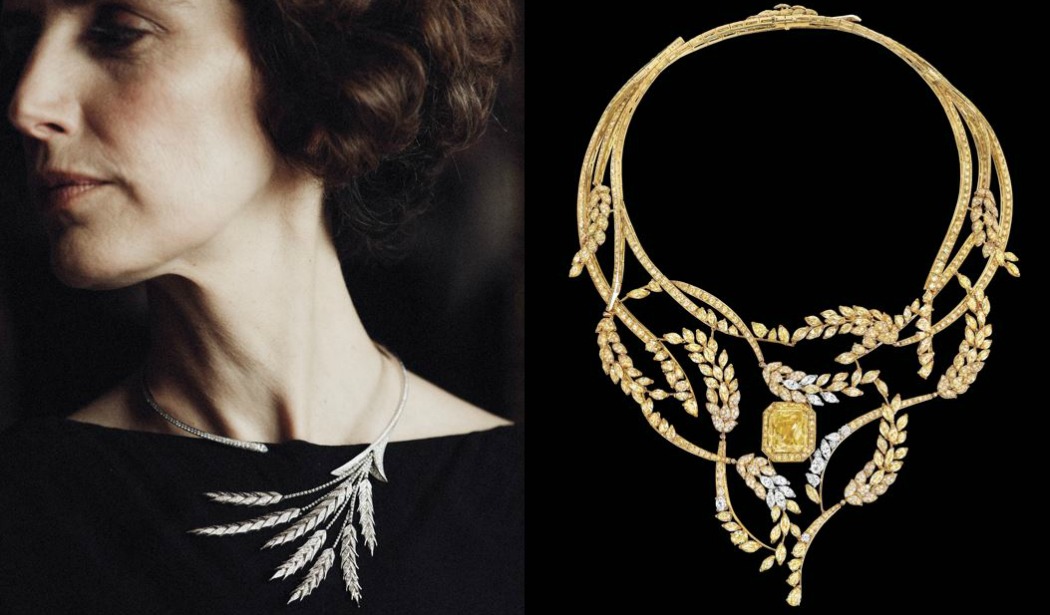A Dazzling Harvest of Haute Joaillerie from Chaumet, Boucheron, and Chanel
For a few days in July, half of Place Vendome, Paris was transformed into an urban wheat field with over a million painted wheat stalks bending to the gentle breeze. The poetic art installation, “Blés Vendôme,” by French street artist Gad Weil had been sponsored by Chanel and timed to coincide with the presentation of its new high jewelry collection, Les Blés de Chanel. Laid out like a formal French garden that you could stroll through, the ephemeral work offered viewers “a moment to reflect, a moment to just pause for a second in their busy life,” the artist explained.
The installation was a fitting introduction to a week of high jewelry presentations, where Chaumet and Boucheron also offered dazzling interpretations of golden ears of wheat.
A symbol of prosperity and abundance, wheat has long been interpreted in high jewelry. In 1811, Empress Marie-Louise, Napoleon’s second wife, commissioned the jeweler Etienne Nitot (founder of Chaumet) to create 150 wheat stalks to adorn her gown and hair. This was the start of a love affair with the wheat motif for Chaumet that would appear again and again in ethereal tiaras and brooches. One of the jeweller’s most important historic pieces remains a tiara for Marie-Louise composed of nine stalks of wheat, created in gold, silver, and diamonds, that seem to rustle in the wind, an expression of modernity flowing through the French Empire.
For its new La Nature de Chaumet collection, the maison aims to highlight four key plants that have over the years not only provided regular sources of inspirations (laurel, oak, lily, and wheat), but ultimately also express the essence and style of the brand.
Wheat sheaves, as if freshly gathered from the fields, were highlighted with diamonds representing luminous grains bursting with life while elegant ribbons bound the sheaves adding to the sophisticated femininity of the jeweled pieces, and by keeping the ribbon unstructured, even on those that were enhanced by a pear-shaped diamond drop, the jeweler embraced the natural wildness in this refined presentation.
As if bending under a soft breeze, golden ears swollen with diamonds of different cuts (brilliant-cut, pear-shaped, and marquise-cut), wrapping around a finger with their stem in brushed yellow gold giving the pieces a 1980s feel.
In a poetic note, Chaumet also renders a wheat field bathed in summer’s evening glow, using the orangey pink of Padparadscha sapphires from Sri Lanka in an open-worked wheat motif on a large cuff.
For Chanel, it was the first foray into a dazzling field of wheat, even though designer Karl Lagerfeld had previously used wheat ears as a motif in his Spring 2010 collection. Gabrielle ‘Coco’ Chanel had a real liking for the plant, which she saw as a symbol of prosperity and regeneration, so much so that Salvador Dali had created a small painting of a single wheat shaft for her in 1947. She turned the plant into one of her (many) lucky charms and decorated her rue Cambon apartment and her suit at the Ritz with furniture that comprised elements of wheat, for example in the feet of a table.
For this first high jewelry collection on the theme, “Les Blés de Chanel,” the maison decided to show the life cycle: the new seedlings sprouting from the ground; tender young shoots rendered with diamonds, peridots, crystallines, and aquamarines to play with transparency of the young ears; and fully developed stalks basking in a golden sun. Amongst the unique pieces, the long necklace “Moisson d’Or” offers a small wheat sheaf in diamonds and yellow sapphires gathered by a yellow sapphire of 16.8 carats, while “Fête des Moissons” evokes paysan crowns of braided wheat with a chunky necklace sporting in its center a yellow rectangular diamond of 25 carats.
Boucheron also focused on the lucky charm aspect of wheat where, according to French folklore, plucking seven ears of wheat from seven fields on June 24 (the feast day of St. Jean the Baptiste) was considered to ensure good fortune. Creative director Claire Choisne rendered her wheat in a realistic way, as if swaying in the wind, and re-interpreted Boucheron’s famed asymmetrical question mark necklace, a classic dating back to 1881, with seven ears of wheat fanning out elegantly. Each ear is fully articulated to sit comfortably across the collarbone and is created in white gold paved with tiny diamonds. Choisne complements the necklace with a ring and cuff, coiling three ears of wheat in an open, airy design.
Boucheron’s “26 Vendôme” high jewelry collection, which also included pieces inspired by architecture, animals, and couture, was presented during Paris Couture Week through a piece of performance art organized by Olivier Saillard, the director of the Palais Galliera Musée de la Mode.
As first published on BlouinArtinfo.com









